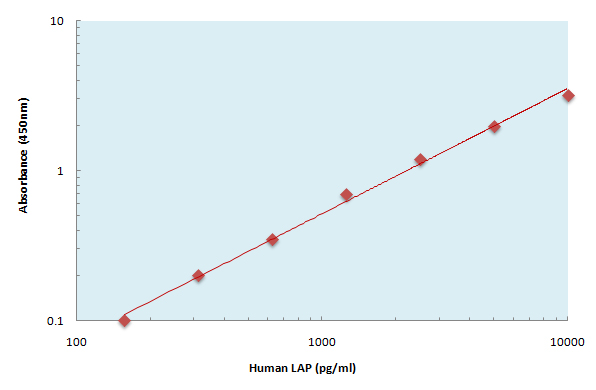Total TGFβ1 Cell-Based Colorimetric ELISA Kit
- Catalog No.:KA3390C
- Applications:ELISA
- Reactivity:Human;Mouse;Rat
- Gene Name:
- TGFB1 TGFB
- Protein Name:
- Transforming growth factor beta-1, TGF-β1, TGF b
- Human Gene Id:
- 7040
- Human Swiss Prot No:
- P01137
- Mouse Swiss Prot No:
- P04202
- Rat Swiss Prot No:
- P17246
- Storage Stability:
- 2-8°C/6 months
- Other Name:
- Transforming growth factor beta-1 (TGF-beta-1) [Cleaved into: Latency-associated peptide (LAP)]
- Detection Method:
- Colorimetric
- Background:
- disease:Defects in TGFB1 are the cause of Camurati-Engelmann disease (CED) [MIM:131300]; also known as progressive diaphyseal dysplasia 1 (DPD1). CED is an autosomal dominant disorder characterized by hyperostosis and sclerosis of the diaphyses of long bones. The disease typically presents in early childhood with pain, muscular weakness and waddling gait, and in some cases other features such as exophthalmos, facial paralysis, hearing difficulties and loss of vision.,function:Multifunctional protein that controls proliferation, differentiation and other functions in many cell types. Many cells synthesize TGFB1 and have specific receptors for it. It positively and negatively regulates many other growth factors. It plays an important role in bone remodeling as it is a potent stimulator of osteoblastic bone formation, causing chemotaxis, proliferation and differentiation in committed osteoblasts.,induction:Activated in vitro at pH below 3.5 and over 12.5.,online information:TGF beta-1 entry,polymorphism:In post-menopausal Japanese women, the frequency of Leu-10 is higher in subjects with osteoporosis than in controls.,PTM:Glycosylated.,PTM:The precursor is cleaved into mature TGF-beta-1 and LAP, which remains non-covalently linked to mature TGF-beta-1 rendering it inactive.,similarity:Belongs to the TGF-beta family.,subunit:The inactive form consists of a TGFB1 homodimer non-covalently linked to a latency-associated peptide (LAP) homodimer. The inactive complex can contain a latent TGFB1-binding protein. The active form is a homodimer of mature TGFB1; disulfide-linked. Heterodimers of TGFB1/TGFB2 have been found in bone. Interacts with CD109 and DPT.,tissue specificity:Highly expressed in bone.,
- Function:
- regulation of DNA recombination, protein import into nucleus, translocation, cell cycle checkpoint, cell morphogenesis,cell morphogenesis involved in differentiation, skeletal system development, ossification, regulation of action potential,regulation of cell growth, response to hypoxia, morphogenesis of a branching structure, myeloid dendritic cell activation, cell activation, leukocyte homeostasis, regulation of cytokine production, positive regulation of cytokine production, epithelial to mesenchymal transition, regulation of protein amino acid phosphorylation, negative regulation of protein amino acid phosphorylation, positive regulation of protein amino acid phosphorylation, healing during inflammatory response, connective tissue replacement during inflammatory response, lymphocyte homeostasis,myeloid leukocyte activation, tolerance induction, tolerance induction to self antigen, im
- Subcellular Location:
- [Latency-associated peptide]: Secreted, extracellular space, extracellular matrix .; [Transforming growth factor beta-1]: Secreted .
- Expression:
- Highly expressed in bone (PubMed:11746498, PubMed:17827158). Abundantly expressed in articular cartilage and chondrocytes and is increased in osteoarthritis (OA) (PubMed:11746498, PubMed:17827158). Colocalizes with ASPN in chondrocytes within OA lesions of articular cartilage (PubMed:17827158).
Protective effect of melatonin entrapped PLGA nanoparticles on radiation-induced lung injury through the miR-21/TGF-β1/Smad3 pathway. INTERNATIONAL JOURNAL OF PHARMACEUTICS Int J Pharmaceut. 2021 Jun;602:120584 ELISA Mouse Serum,lung
- June 19-2018
- WESTERN IMMUNOBLOTTING PROTOCOL
- June 19-2018
- IMMUNOHISTOCHEMISTRY-PARAFFIN PROTOCOL
- June 19-2018
- IMMUNOFLUORESCENCE PROTOCOL
- September 08-2020
- FLOW-CYTOMEYRT-PROTOCOL
- May 20-2022
- Cell-Based ELISA│解您多样本WB检测之困扰
- July 13-2018
- CELL-BASED-ELISA-PROTOCOL-FOR-ACETYL-PROTEIN
- July 13-2018
- CELL-BASED-ELISA-PROTOCOL-FOR-PHOSPHO-PROTEIN
- July 13-2018
- Antibody-FAQs

